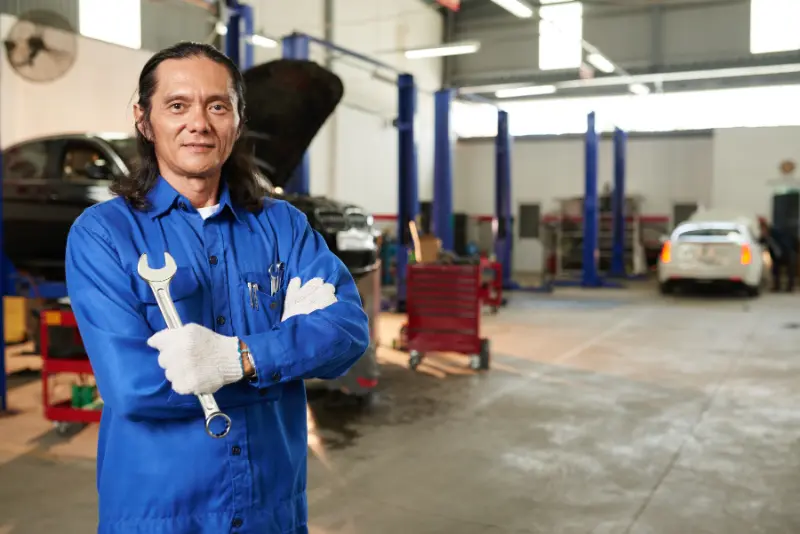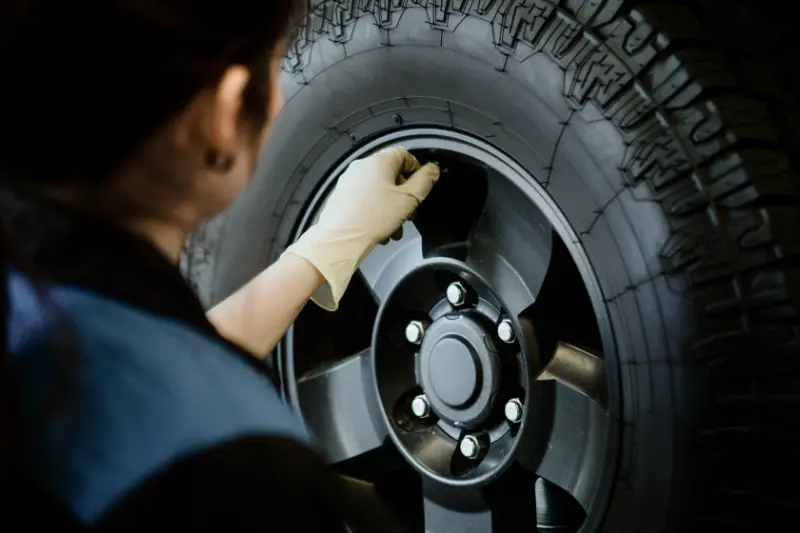What are the most common MOT fails, and how can you avoid them? From ineffective brakes to faulty lighting, our detailed guide walks you through the frequent issues that keep vehicles from passing the MOT test and how to address them, setting the stage for a successful inspection.
Key Takeaways
- The MOT test ensures vehicle roadworthiness by inspecting key components like brakes, suspension, headlights, and exhaust to adhere to safety and environmental standards. It results in a certificate of passing.
- Common reasons for MOT test failures include lighting and signalling defects, suspension and braking system issues, and impaired driver vision due to obstructions or inadequate windscreen wipers. All of these can be avoided with regular checks and maintenance.
- Vehicle maintenance extends to tyre condition, structural integrity safeguarded against rust, compliant registration plates, emissions control, particularly for diesel vehicles, and functional safety components such as seat belts and airbags.

Understanding MOT Test Essentials
The MOT test, an essential assessment of your vehicle’s key components, is designed to ensure that your car is roadworthy. It’s not just about ticking off a legal requirement; it’s about safeguarding your life and the lives of others on the road.
The MOT test is comprehensive and guided by specific manuals that detail each element that is inspected. Some of the key components that are checked include:
- Brakes
- Suspension
- Headlights
- Exhaust
Every critical part is scrutinised to ensure it adheres to safety and environmental standards.
But what is the reward for passing the test? A test certificate. This isn’t just a piece of paper. It’s your ticket to the road, proof that your vehicle meets the required safety and environmental standards – all for the cost of a test fee.
Top Reasons Vehicles Fail the MOT
Now that we understand the basics of the MOT test let’s delve into the top reasons why vehicles often fail. Knowing these common MOT failures can mean the difference between a pass and a fail, ensuring a smoother ride towards securing that coveted MOT certificate. In this article, we will discuss common MOT fails and how to avoid them.
Numerous factors can cause a vehicle to fail the MOT test, from lighting and signalling issues to braking system troubles. These problems often lurk beneath the surface, unnoticed until the MOT test brings them to light. But fear not. With regular checks and maintenance, these pitfalls can be avoided.
Illumination Issues: Beyond Just Headlights
Let’s examine the most common cause of MOT test failures: lighting and signalling defects. These issues account for nearly a fifth of all MOT test failures, a significant percentage considering that something as simple as a blown bulb can cause this predicament.
Fortunately, avoiding this common MOT fail is as straightforward as taking a walk around your car. Switch on all the lights, take a stroll around your vehicle, and ensure that every light is shining bright. From your:
- fog lights
- brake lights
- headlights
- indicators
- reversing lights
Every light counts when it comes to passing the MOT test, especially broken lights. Ensuring all lights are functioning properly before your vehicle passes the test can avoid the full test fee.
Suspension System Setbacks
Suspension issues – the unseen villain in the MOT test failure saga. Accounting for more than 10% of MOT failures, the suspension system often suffers in silence, with problems gradually surfacing over time.
Potholes, a familiar foe on UK roads, are a significant cause of suspension failures. They can damage your vehicle’s suspension system, leading to uneven vehicle height and excessive bouncing. So, the next time you take your car for a ride, keep an eye out for these road nuisances and ensure a smoother journey towards passing the MOT test.
Braking Bad: Common Faults in Brakes
A well-functioning braking system is at the heart of any safe vehicle. Yet, braking system troubles account for about 10% of MOT failures. From worn-out brake pads to a spongy brake pedal, several issues can compromise your vehicle’s braking efficiency.
But how can you avoid these braking blunders? Start by listening to your vehicle. Squealing or grinding noises from the brakes often indicate low brake pads. And if your car pulls to one side during braking, it could be a sign of a braking system fault. Regular checks and maintenance can ensure that your brakes are in top shape and ready to ace the MOT test.
Driver’s Vision and Vehicle Safety
Next on our journey through common MOT failures, including vehicle failures, is the driver’s vision. A clear field of vision is essential for safe driving. However, something as small as a misplaced air freshener can obstruct the driver’s view and lead to an MOT failure.
Preventing visibility-related MOT failures is a matter of regular checks and maintenance. From removing inside obstructions to ensuring effective windscreen wipers, every little detail counts. A clear windscreen isn’t just a requirement for passing the MOT test; it’s a crucial element of vehicle safety.
Wheel and Tyre Tribulations
As we navigate the most common MOT failures, let’s turn our attention to wheels and tyres. From insufficient tread depth to under-inflation, numerous tyre troubles can lead to MOT failure.
Regular checks and maintenance can keep tyre troubles at bay. Ensure your tyres have the minimum legal tread depth and check for any sidewall damage. Remember, a smooth journey towards passing the MOT test starts with a set of well-maintained tyres.

Keeping Your Car’s Anatomy in Check
A car’s anatomy is more than just its sleek exteriors and plush interiors. The vehicle’s structural integrity, often compromised by rust, is a crucial factor in passing the MOT test.
Preventing rust is a matter of regular washing, drying, and waxing. Early treatment of surface rust can save you from major repairs and MOT failures. Remember, a well-maintained car is not just about aesthetics; it’s about ensuring a safe and smooth ride.
Ensuring Roadworthy Registration Plates
Registration plates, often overlooked in vehicle maintenance, can be a hurdle in passing the MOT test. From being clearly visible and legible to being illuminated at night, several factors play into ensuring roadworthy registration plates.
Keep your registration plates clean and compliant with regulations to avoid fines and MOT failures. Remember, your registration plate is your vehicle’s identity on the road; make sure it’s always legible and visible.
The Exhaust and Emissions Enigma
As we navigate the common MOT failures, let’s delve into the exhaust and emissions enigma. Diesel vehicles, in particular, must adhere to specific emission standards to pass the MOT test.
Ensure compliance with emission standards, from the mandatory diesel particulate filter (DPF) to the selective catalytic reduction (SCR) system. By keeping your vehicle’s emissions in check, you can avoid MOT failures and contribute to a greener environment.
Seat Belt and Airbag Assurance
Seat belts and airbags, the unsung heroes of vehicle safety, play a crucial role in the MOT test. From retracting correctly to being present and functional, these safety components must meet specific standards to pass the MOT test.
Regular checks can ensure that your seat belts and airbags are in top shape, ready to protect you in case of an accident and help you pass the MOT test. Remember, your vehicle’s safety components are your first line of defence on the road; ensure they’re always in top shape.
Navigating the MOT Process at Ivydene Garage Ltd.
Choosing the right MOT test centre can make a world of difference in your vehicle’s MOT journey. Ivydene Garage Ltd., a recognised Bosch Center of Excellence, offers Class 4 MOT tests suitable for a wide variety of vehicles.
With Ivydene Garage Ltd., you’re ensuring access to a trusted establishment with the capability to handle a diverse range of vehicles. So, when it’s time for your vehicle’s next MOT test, consider Ivydene Garage Ltd. – a partner in your journey towards passing the MOT test.
Summary
As we reach the end of our journey through the common MOT failures, it’s clear that regular checks and maintenance are crucial to passing the MOT test. From lighting and signalling issues to tyre troubles, from rust prevention to emission standards, every little detail counts.
Ensuring your vehicle’s roadworthiness is not just about passing the MOT test; it’s about safeguarding your life and the lives of others on the road. So, the next time your vehicle is due for an MOT test, remember these tips and ensure a smoother journey towards securing that coveted MOT certificate.
Frequently Asked Questions
What does a car service typically include?
A car service typically includes checking fluids and brakes and providing manufacturer-recommended maintenance based on the vehicle’s age and mileage. Regular servicing helps ensure the vehicle’s optimal performance and safety.
How long has Ivydene Garage been a Bosch agent?
Ivydene Garage Ltd has been a Bosch agent for over 32 years.
What types of vehicles are suitable for Class 4 MOT tests?
Cars, small vans, and motor caravans up to 3,000kg (3 tonnes) are suitable for Class 4 MOT tests.
What is the purpose of an MOT test?
An MOT test ensures that all vehicles on the road meet specific safety and environmental standards.
What are the common MOT fails?
Common MOT fails often involve lighting and signalling problems, suspension issues, braking system troubles, driver’s vision problems, and tyre issues. Keeping these in mind can help ensure a successful MOT test.
